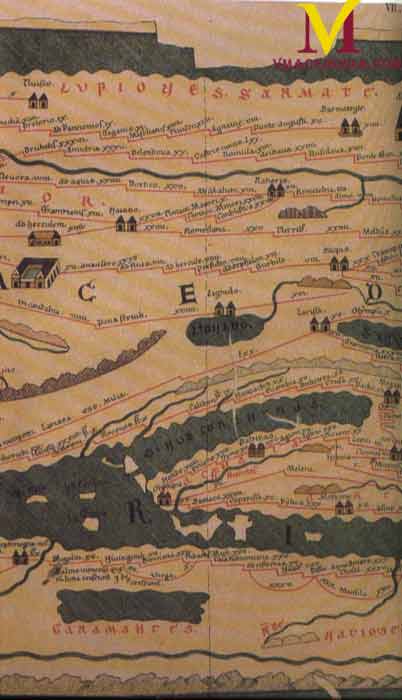Ohrid is one of the rare cities in the Balkans, such as Thessalonika, Odessa and Dyrachion that had thrived uninterruptedly throughout the classical period. These cities survived the decline of the classical civilization and continued to live under their new names till the present time. The soil of this ancient city has seen numerous changes of civilization achievements followed by the inevitable falls and rises.
The contemporary city of Ohrid is a descendant of the antique town of Lychnidos. This was confirmed by several Byzantine sources in which it was written “the town is situated on a high hill near the large lake of Lychnidos, by which also the town was named Lychnis, previously known as Dyassarites”. The existence of this town is also evident from numerous Roman documents. According to them, Lychnidos was located by the Via Egnatia, the oldest and most important Roman roadway in the Balkans. It started with two routes from Apollonia and Dyrachia and reached to Lychnidos through Candavian Mountains. Long before the Romans came into the region this route had been used as a communication link between the coast and the internal parts of Illyria and Macedonia. Via Egnatia was the shortest route from Rome to the Eastern Empire.
The earliest inhabitants of the widest Lake Ohrid region that can be identified by name were Brigians and Enhelians. Brigians are the same as Phrygians. According to Herodotus, the Phrygians from Asia Minor used to live in Europe in the vicinity of the Macedonians and were called Brigians. After the Troy War they migrated to Asia Minor and changed their name into Phrygians.
Historically, Enhelians have been identified as Illyrians. However, it should be underlined that Herodotus, and some other historians, distinguish them from the Illyrians.
The origin of their name, Enhelians, derives from encheleus -“eel”, “serpent”, and connects this people with the Lychnidos Lake since it is rich in eel. During the Roman conquests, towards the end of III and the beginning of II century BC, Desaretes and the region Desaretia were mentioned, as well as the town of Lychnidos, Lychnidus and the region Lychnis. Desaretia was a vast region that stretched from Devol in the west to the Macedonian regions of Orestidia and Lynkestidia to the east. Lychnitidia, the region around Lake Ohrid, in the beginning emerged as a separate region outside the borders of Desaretia.
After the Roman conquest, the name Desarets appeared as the joint name of all tribes that lived in the mountainous region inside the area of Macedonia and South Illyria, stretching from the border with Epirus in the south to the Parthynes and Phenestes in the north and Lynkestes in the east.
Lychnidos then became the capital of Desaretia.
Data on the political development of the Lychnidos region in the classical period is scarce and comes from preserved written documents. The first indicators of the political character of the region relate to the V century BC when during the Pelophonnesus War in Greece on the northern border of Macedonia, a political community emerged. This community, named “Illyrians” by the classical writers, seriously threatened the safety of the Macedonian State at times.
It is said that the Illyrians held Macedonia enslaved before Philip II of Macedonia come to power. With the arrival of Philip II the power shifted. This happened after the battle that most probably took place in Lynchestidis, today the Bitola Plain. The victorious party was the Macedonians. This battle was crucial for the further development of the relations between Illyria and Macedonia. It marked the end of the Illyrian domination over Macedonia. The Illyrians had to leave the region east of the northern shore of Lychnidos Lake.
In the year 335 BC, while Alexander III of Macedonia was on the river Danube, the Illyrian king Klit organized an insurrection against Macedonia. The sources do not mention the consequences of Alexander’s victory over Klit. Several indirect data have shown that as a result Illyria was annexed to Macedonia, probably as a province under the administration of a strategist, as was the case with Trachia ever since the rule of Philip II.
During this period the region of Lychnidos was part of the Hellenic civilization and did not belong to the Latin speaking regions.
In the III century BC Rome expressed its aspiration towards the Balkans. Military actions begun and the Illyrian territories were used as starting bases in the war against the mighty Macedonian State. The Roman Empire lead three wars against Macedonia where the Macedonians, during the rules of Philip V and Perseus, tasted defeat for the first time. The whereabouts of these defeats are not precisely known. Perhaps they even happened in the region of Lychnidos. After the Third Macedonian War against King Perseus, Lychnidos became the main Roman base in the northern regions of Macedonia. It was at this exact time that the name was frequently heard.
In 148 BC Macedonia became a Roman colony that stretched to the Adriatic Sea to the west. The situation remained unchanged throughout the Early Roman Empire. Within the province, Dasaretia together with Lychnidos retained its status of a free community – one chronicle writer described Dasaretians as libera gens.
As a main centre of Dasaretians, Lychnidos had a great significance during the period of Roman Republic. The importance of Lychnidos is evident from numerous epigraphic monuments found in Ohrid. These monuments were erected by Dasaretians and their governmental bodies and are amongst the most important remnants of ancient Ohrid.
During the Late classical period Lychnidos was mentioned as an episcopal centre. The exact date of the foundation of the Lychnidos Episcopacy is not known. It was first mentioned in the acts of the church conclave in Serdika (343 AD) where Dionysius de Macedonia de Lychnido appears as one of the signatories. In fact, Dionysius is the only known bishop in Lychnidos in IV century.
Lychnidos was last mentioned on the occasion of its destruction. Among all the rest of heavy disasters that struck the Roman Empire during the reign of Ustinian (wars, floods, plague), earthquakes were also noted. According to the historical sources, in the earthquake that occurred on 29th and 30th May 526 AD, several thousand people from Lychnidos were killed. There are no further records of Lychnidos in historical documents. It also remains unclear whether or not Justinian rebuilt the town?

Virtual Macedonia
Republic of Macedonia Home Page
Here at Virtual Macedonia, we love everything about our country, Republic of Macedonia. We focus on topics relating to travel to Macedonia, Macedonian history, Macedonian Language, Macedonian Culture. Our goal is to help people learn more about the "Jewel of the Balkans- Macedonia" - See more at our About Us page.
Leave a comment || Signup for email || Facebook |
History || Culture || Travel || Politics















